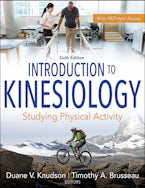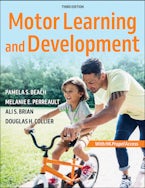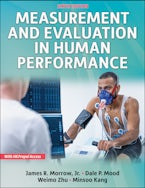- Home
- Foundations of Kinesiology/Exercise and Sport Science
- Kinesiology/Exercise and Sport Science
- Introduction to Kinesiology

Introduction to Kinesiology
Studying Physical Activity
Edited by Duane V. Knudson and Timothy A. Brusseau
480 Pages
Introduction to Kinesiology: Studying Physical Activity, Sixth Edition With HKPropel Access, offers students a comprehensive overview of the field of kinesiology and explores the subdisciplinary fields of study, common career paths, and emerging ideas that are part of this dynamic and expanding discipline. This engaging, full-color introductory text stimulates curiosity about the vast field of kinesiology and generates awareness of the long-standing and current issues that kinesiology professionals seek to understand and solve.
Introduction to Kinesiology, Sixth Edition, features a three-section structure that has always been a strength of this leading introductory textbook. Part I examines the diversity of physical activity and kinesiology and summarizes the importance of knowledge gained through physical activity experiences. Part II delves into the seven major subdisciplines of kinesiology, with an overview of major historical events, research methods, professional work and application, and ideas for career advancement in each. Part III elaborates on professionalism and then examines five main areas for career opportunities.
With hundreds of updated references, the sixth edition includes the latest research and data available as well as an increased emphasis on sensitivity and inclusion. New editor Timothy A. Brusseau, a national youth physical activity expert who has served on the board of directors for the American Kinesiology Association, contributes his expertise and insight to the text. Additional updates to the sixth edition include the following:
- Related online learning tools delivered through HKPropel offer interactive opportunities to engage with and better understand the content.
- Updates to data, research, and graphics incorporate the most recent discoveries.
- New Research and Evidence-Based Practice in Kinesiology sidebars highlight influential contemporary studies and discuss how they can be applied in professional settings as an evidence-based practice.
- New Subdisciplinary Highlight sidebars feature trending topics in the subdisciplines of kinesiology.
- New Hot Career Opportunity sidebars discuss emerging career paths for kinesiology and exercise science majors.
Ample learning aids within the text—such as chapter objectives, summaries, key points, and review questions—will also aid in knowledge retention. Opening scenarios at the beginning of each chapter feature a specific athlete, activity, or issue in kinesiology that serves to illustrate the main points.
Introduction to Kinesiology provides essential information for students embarking on their study of kinesiology, and this updated sixth edition prepares them for future courses and further study.
Note: A code for accessing HKPropel is included with all new print books.
Chapter 1. Introduction to Kinesiology
Duane V. Knudson and Timothy A. Brusseau
Interest in the Discipline of Kinesiology
Physical Activity: The Focus of Kinesiology
Some Focuses of Physical Activity in Kinesiology
Kinesiology and Evidence-Based Practice
Wrap-Up
Chapter 2. Importance of the Physical Activity Experience
Timothy A. Brusseau and Duane V. Knudson
Sphere of Self-Sufficiency
Sphere of Self-Expression
Sphere of Work
Sphere of Education
Sphere of Leisure
Sphere of Health
Sphere of Competition
Factors That Influence Kinds of Experience in Physical Activity
Ways in Which Experience Can Affect Physical Activity
Heredity and Experience
Subjective Experience of Physical Activity
Wrap-Up
Part II. Scholarly Study of Physical Activity
Chapter 3. Philosophy of Physical Activity
Cesar R. Torres and Scott Kretchmar
Why Use Philosophical Thinking?
What Do Philosophers Do?
Research Methods for Philosophy of Physical Activity
History and Future of Philosophy of Physical Activity
Overview of Knowledge in Philosophy of Physical Activity
Wrap-Up
Chapter 4. History of Physical Activity
Lindsay Parks Pieper
Why Use History of Physical Activity?
What Do Historians of Physical Activity Do?
History of Kinesiology and Physical Activity
Research Methods for History of Physical Activity
Overview of Knowledge in History of Physical Activity
Wrap-Up
Chapter 5. Sociology of Physical Activity
Katherine M. Jamieson
Why Use Sociology of Physical Activity?
What Do Sociologists of Physical Activity Do?
History of Sociology of Physical Activity
Research Methods for Sociology of Physical Activity
Overview of Knowledge in Sociology of Physical Activity
Wrap-Up
Chapter 6. Motor Behavior
Katherine T. Thomas, Xiangli Gu, and Jerry R. Thomas
Why Use Motor Behavior?
What Do Motor Behaviorists Do?
History of Motor Behavior
Research Methods for Motor Behavior
Overview of Knowledge in Motor Behavior
Wrap-Up
Chapter 7. Sport and Exercise Psychology
Robin S. Vealey
Why Use Sport and Exercise Psychology?
What Do Sport and Exercise Psychology Professionals Do?
History of Sport and Exercise Psychology
Research Methods for Sport and Exercise Psychology
Overview of Knowledge in Sport and Exercise Psychology
Wrap-Up
Chapter 8. Biomechanics of Physical Activity
Kathy Simpson
Why Use Biomechanics of Physical Activity?
What Do Biomechanists Do?
History of Biomechanics
Research Methods for Biomechanics
Overview of Knowledge in Biomechanics
Wrap-Up
Chapter 9. Physiology of Physical Activity
Jennifer L. Caputo
Why Use Physiology of Physical Activity?
What Do Exercise Physiologists Do?
History of Physiology of Physical Activity
Research Methods for Physiology of Physical Activity
Overview of Knowledge in Physiology of Physical Activity
Wrap-Up
Part III. Practicing a Profession in Physical Activity
Chapter 10. Becoming a Physical Activity Professional
Duane V. Knudson and Timothy A. Brusseau
What Is a Profession?
How Do Our Values Shape Our Professional Conduct?
How Are Physical Activity Professionals Educated for the Workforce?
Are You Suited for a Career in the Physical Activity Professions?
Wrap-Up
Chapter 11. Careers in Health and Fitness
Warren D. Franke
The Need for Health and Fitness Professionals
Settings for Health and Fitness
Roles for Health and Fitness Professionals
Trends and Opportunities in Health and Fitness
Advice for Health and Fitness Students
Wrap-Up
Chapter 12. Careers in Medicine and Allied Health
Chad Starkey
The Diagnostic Process
Integrating Exercise Into Medicine and Allied Health
Medical and Allied Health Settings
Roles for Medical and Allied Health Professionals
Trends and Opportunities in Medicine and Allied Health
Advice for Students Interested in Medicine and Allied Health
Wrap-Up
Chapter 13. Careers in Teaching Physical Education
Kim C. Graber and Thomas J. Templin
What Is the Teaching of Physical Education?
Settings for Teaching Physical Education
Roles for Physical Education Professionals
Trends and Opportunities in Teaching Physical Education
Advice for Physical Education Students
Wrap-Up
Chapter 14. Careers in Coaching and Sport Instruction
Joseph A. Luxbacher and Duane V. Knudson
What Are Coaching and Sport Instruction?
Settings for Coaching and Sport Instruction
Roles for Coaching and Sport Instruction Professionals
Trends and Opportunities in Coaching and Sport Instruction
Advice for Coaching and Sport Instruction Students
Wrap-Up
Chapter 15. Careers in Sport Management
G. Clayton Stoldt and Mark C. Vermillion
What Is Sport Management?
Settings for Sport Management
Roles for Sport Management Professionals
Trends and Opportunities in Sport Management
Advice for Sport Management Students
Wrap-Up
Duane V. Knudson, PhD, is a Regents’ and University Distinguished Professor in the department of health and human performance at Texas State University, where he teaches biomechanics. He earned his doctorate at the University of Wisconsin–Madison and has held tenured faculty positions at three universities. His research areas are in the biomechanics of tennis, stretching, qualitative movement diagnosis, and learning biomechanical concepts.
Knudson has authored over 150 peer-reviewed articles, 22 chapters, and three books: Fundamentals of Biomechanics, Qualitative Diagnosis of Human Movement, and Biomechanical Principles of Tennis Technique. He has received numerous state, regional, national, and international awards for his research and leadership. Knudson has been elected fellow of four scholarly societies, including the prestigious National Academy of Kinesiology. He has served as department chair, associate dean, and president of the American Kinesiology Association and as president of the International Society of Biomechanics in Sports.
Timothy A. Brusseau, PhD, is an associate professor and the chair of health and kinesiology at the University of Utah. He earned his PhD at Arizona State University and previously served on the faculty at the State University of New York at Brockport. Brusseau is a national expert on youth physical activity, physical activity measurement, and school-based multicomponent physical activity interventions. He has more than 145 peer-reviewed publications and has made more than 180 conference and invited presentations on topics related to youth physical activity. He is coauthor of Dynamic Physical Education for Secondary School Students and associate editor of Research Quarterly for Exercise and Sport. He has received numerous awards for his teaching and research. He is currently on the board of directors of the American Kinesiology Association and is a fellow in the American College of Sports Medicine.










